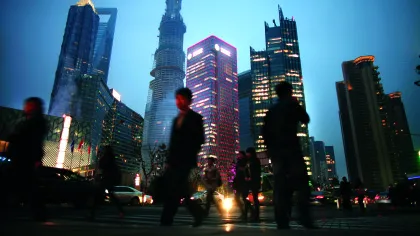
INDUSTRY ROUNDUP Asia's dynamic retail markets
Global brands are expanding into Asia Pacific at an unprecedented rate as a result of rapid urbanisation and a growing middle class. But which country will reign supreme as Asia’s retail hotspot? Lee Fong, senior manager at JLL Research Asia Pacific, based in Hong Kong,explores trends shaping the region’s key shopping destinations.
Almost daily I come across a news article announcing the arrival of an international retailer in Asia Pacific. Zara, H&M, Forever 21, Brooks Brothers: just a few of the global brands to have set up shop in the region in recent years.
And that’s just the fast fashion retailers. The luxury sector has seen staggering growth, following a strong rebound from the global financial crisis.China alone could account for over 20% of the world’s total luxury spend by 2015.However, recently consumers have become more discerning about the purchase of luxury goods.
While the region’s markets – from Singapore to Indonesia – vary wildly in their different stages of development,retail growth is largely influenced by three dominant factors: urbanisation, a growing middle class and rising tourism.
In emerging Asia, rapid urbanisation has resulted in 40 million more people living in cities each year, driving wealth creation. Asia Pacific currently accounts for around one-third of the world’s middle class population and this is projected to reach 46% (1.32 billion people) by 2020.
This highlights huge market potential for retailers.
A region of contrast
Incomes for city dwellers generally surpass those in rural areas and the middle class population is fuelling a rise in discretionary spending.
Anyone who has ever walked through the streets or malls in Causeway Bay or Tsim Sha Tsui in Hong Kong can certainly understand why Hong Kong remains as the region’s top destination for retailers and shoppers alike. These central shopping precincts are packed with global retailers catering to all types of consumers.
While the region has many mature markets such as Hong Kong, Singapore and Tokyo, rapidly growing retail cities such as Delhi, Jakarta and Chongqing, are also gaining attention from retailers and mall operators. As competition intensifies within developing nations, retailers are likely to become more selective about the markets they enter in coming years.
Shopping in second tier cities
In emerging markets, retail development of peripheral districts, second and third tier cities will gain prominence. Many retailers will adapt their strategiesto secure first-mover advantage in these areas.
In Jakarta, retail growth is increasingly taking place in ‘decentralised malls’ in peripheral districts of the capital. This is being driven by high occupancy in core malls, combined with limited supply due to the government limiting the number of newly created malls in the city centre.
In India, uncertainty surrounding foreign direct investment into multi-brand retailing is creating a focus on single brand stores for international retailers. Despite such challenges, retailers and mall operators will continue to be attracted to the region’s vast growth opportunities.
Another trend we are seeing is in Australia, with more international brands heading Down Under. Until recently, the market was dominated by domestic retailers. This expansion is driven, in part, by the nation’s strong e-commerce foundation. Retailers have found a footing online and are looking to extend to the malls. It is also a chance for many brands to consolidate their position in Asia Pacific.
A more sophisticated shopper
As the region’s demographic and income trends change, the demand for modern shopping facilities is growing. Shopping centre stock has exploded over the past decade, largely driven by a substantial increase in China.
However, with more discerning consumers, a growing presence of international retailers and the rapid adoption of technology, it is becoming increasingly important to focus on the all-round shopping experience.
Malls in China, in particular are increasingly characterised by attractive scenery, tourist attractions, and experiential features such as art galleries, playgrounds, and riverside dining.
The key to ‘experience retail’ is not about setting up physical activities such as water parks, which leave people too fatigued to shop. New concepts of offline-to-online shopping models are appearing where consumers experience the products and then purchase online in-store.
Dining and entertainment is becoming a key component in malls across the region as more shoppers are enticed to spend the day enjoying the ‘shop, play, eat’ concept under one roof.
The appeal of Asia’s retail hotspots
Bangkok
Bangkok has had a magnetic effect on international retailers in recent years. Many international brands opened their first stores in Thailand in 2Q14. Demand for prime grade retail space remained strong in 2Q14 with Central Embassy and Siam Square One opening and adding 73,600sqm of stock to the market. Despite notable pre-commitment levels, the vacancy rate increased by 0.3% quarter-on-quarter.
Landlords responded to the calming effect of the military coup with a slight uplift in rents, which had been temporarily lowered for those affected by political demonstrations. Capital values were also affected by the return to political stability and rose by 3.5%, reflecting strong investment interest in retail property.
Thai consumer confidence has risen and the number of international tourists to Bangkok is expected to recover soon. Demand for prime space should continue to rise, in turn driving up rents and capital values.
Beijing
Food and beverage operators continue to drive demand for retail space in Beijing with Grandma’s Home, Nanjing Dapaidang, Nan Xiao Guan and Pizza Express opening outlets in 2Q14.
International apparel retailers remain highly selective in terms of location and are keen to open their first stores in Beijing’s key locations.
The retail to office conversion trend continues. For example, Wangjing International Centre closed its 20,000sqm anchor, Yokado Department Store, and converted the space into offices for strata title sale.
Super-regional malls will be the next big thing in Beijing. The next 12 months will see the beginning of a supply wave in the suburban areas of the city following the growth of the urban rail network.
Hong Kong
The retail sector continued to show signs of a slowdown with total retail sales retreating by 7% year-on-year in 2Q14. The decline was led by a 31.5% year-on-year drop in the sales of jewellery and watches.
Despite declining sales, leasing demand in prime shopping locations remained largely intact.
Activity in the investment market recorded a surprising pick-up with investors showing interest in larger size premises with value-add potential in non-core locations.
International retailers, especially mass market retailers, remain keen on using Hong Kong as a springboard to enter the mainland markets. Against this backdrop, rentals are forecasted to rise by 1-2% by the end of 2014.
Jakarta
After a challenging first quarter, where net take-up plunged to a record low, retail demand has rebounded, supported by restored retailer confidence.
Despite a rebound in occupancy levels, tight competition among landlords continued to put downward pressure on rents. No landlord increased rents in 2Q14.
CBD malls saw an increase in occupancy levels with the opening of new outlets by both local and international retailers. Major leases were taken by H&M in Grand Indonesia Shopping Town and Tiffany & Co in Plaza Senayan.
However, limited supply still hampers the market as a result of government provisions. Total prime retail stock remained at 1.37 million sqm with no completions in 2Q14.
Demand for luxury is set to increase across Indonesia, driven by higher incomes and improving lifestyles. This trend is expected to entice more foreign retailers to expand into Jakarta.
Mumbai
Underlying demand for retail space remained higher than the low levels witnessed at the end of 2013. However, a lack of quality mall space and a limited supply of new malls have led to retailers leasing space on prominent high streets.
One new mall (located in Navi Mumbai) became operational in 2Q14 resulting in a 0.6% quarter-on-quarter increase in stock.
Poorly built or managed malls continue to suffer and the overall vacancy rate continued to hover around 20% as absorption in good quality malls was met with rising vacant space in poorly built or managed malls. The majority of poorly built malls have witnessed a rise in vacancy rates over the past two quarters.
Many retailers take wait-and-see approach to India and are holding back on expansion plans due to policy related uncertainties. However, with the formation of a new pro-reform government we may witness a transition in retailer sentiment.
Sydney
International retailers continue to drive leasing activity with US retailer Brooks Brothers committing to a new store in Martin Place in Sydney’s CBD.
The Sydney retail market continues to strengthen as retail turnover growth outpaces the national trend. Leasing market conditions are set to improve, resulting in a reduction in vacancy rates and a modest uplift in rental growth.
Despite low retail investment activity across Australia, the Sydney market has seen a considerable amount of activity. Ten sales transactions totalling AUD$321.8 million were completed in New South Wales in 2Q14. A stable yet robust level of investor demand, combined with a lack of opportunities to acquire assets is driving yield compression in the retail sector.
As construction activity picks up, two major trends are emerging. Institutional landlords are refurbishing and expanding existing centres while two major retail conglomerates (Woolworths and Wesfarmers) are expanding home hardware store chains and supermarkets.
Tokyo
A consumption tax increase implemented in April saw sales of large retail stores in the April-May period decrease 4.9% year-on-year, while sales of luxury goods in department stores declined 32.5% year-on-year for the same period.
Rental growth accelerated in the quarter, marking the seventh consecutive quarter of increase. Capital values trended higher for the third straight quarter rising 9.1% year-on-year.
Kate Spade New York and Weekend Max Mara opened on secondary high streets while Apple and Givenchy opened new stores in the Omotesando area.
The number of visitor arrivals is expected to continue to grow, given the relaxation of travel visas for a number of countries in the past year and the depreciation of the yen.
Other related stories - https://bthrustgrp.com/retaildev/?p=2165



















 Advertise
Advertise






